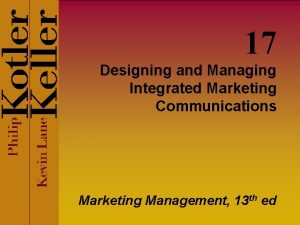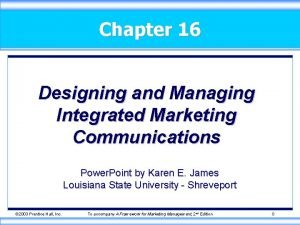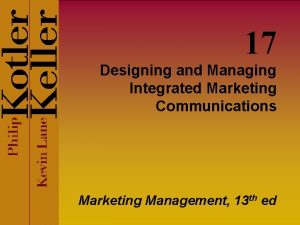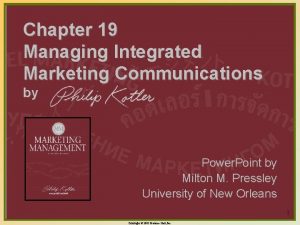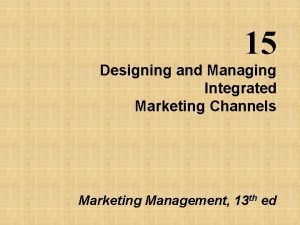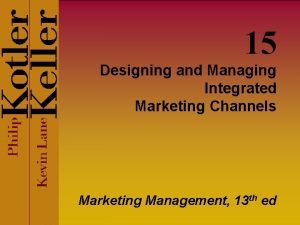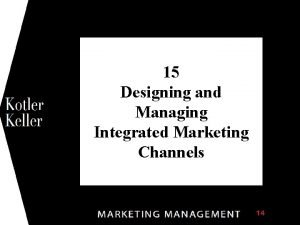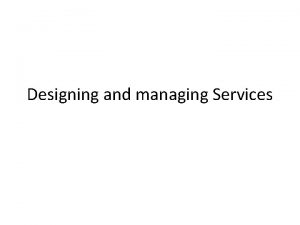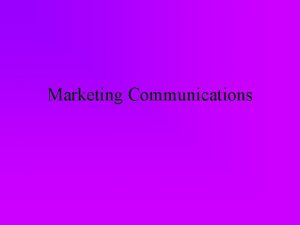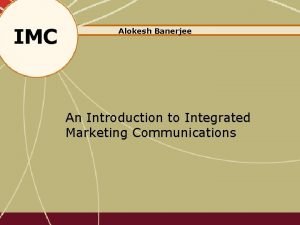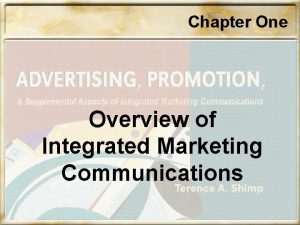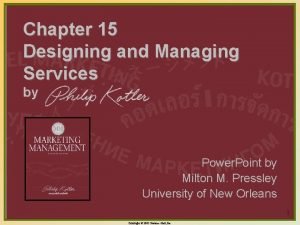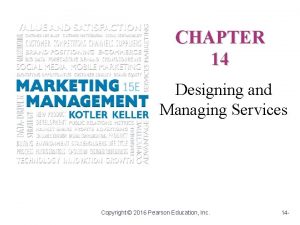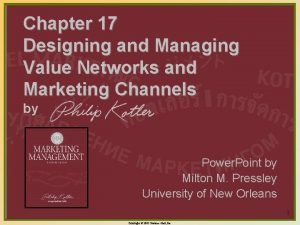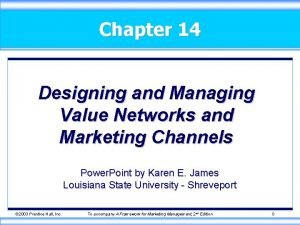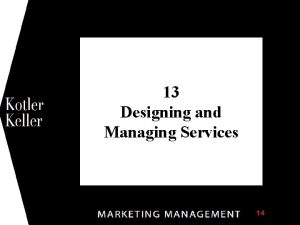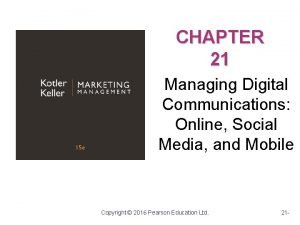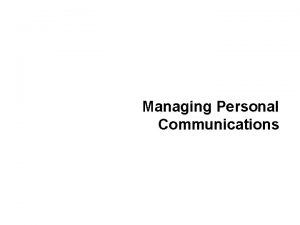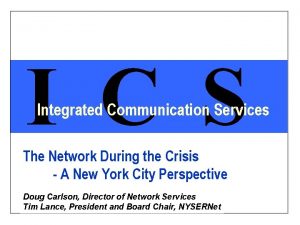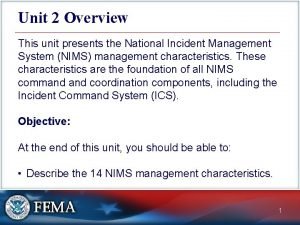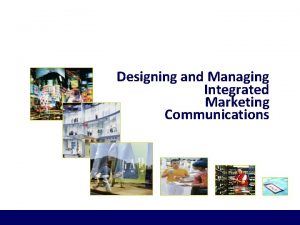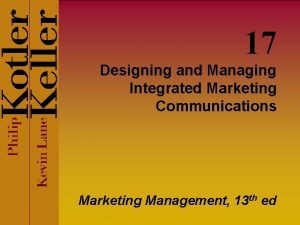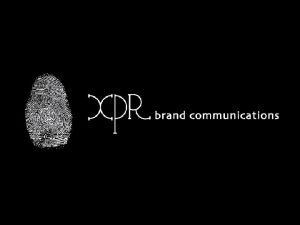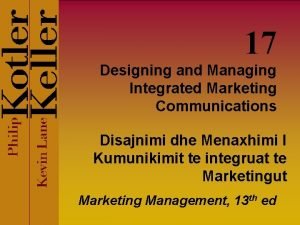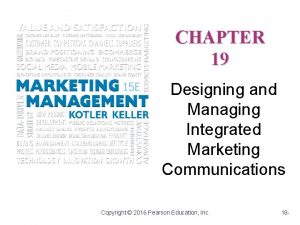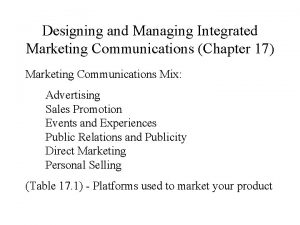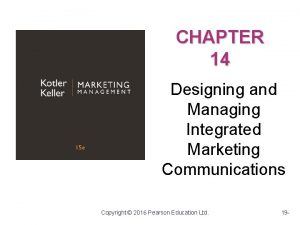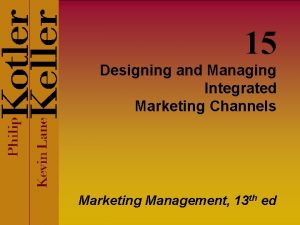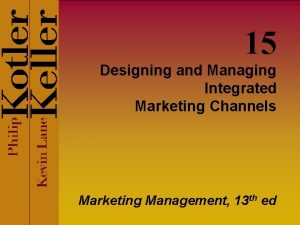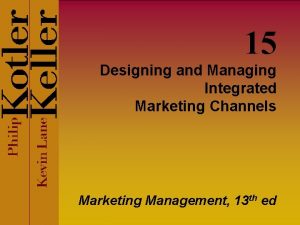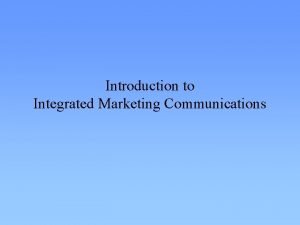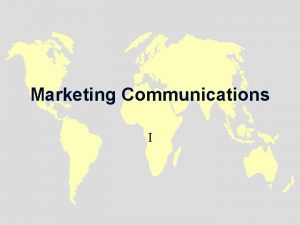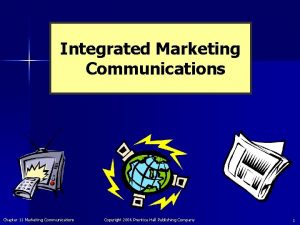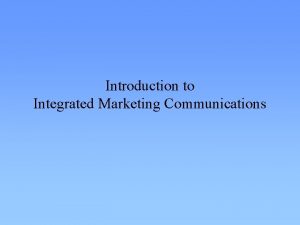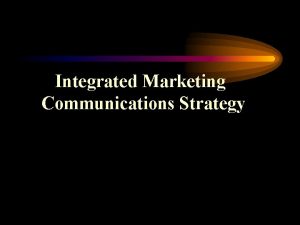Designing and Managing Integrated Marketing Communications What is





























- Slides: 29

Designing and Managing Integrated Marketing Communications

What is Promotion? l l l Communication process in marketing It is used to create a favorable predisposition toward brand concept, services, idea, or person. Implementing the three other marketing mix factors Achieving market segmentation, product differentiation, and positioning Enhancing revenues and profits

Promotional Mix l A blend of communication tools and activities used by a firm l l l Advertising Sales Promotion Publicity/Public Relations Direct Marketing Interactive/Internet marketing Personal Selling

Communication l l Advertising is, first of all, a form of communication. Communication l l l The passing of information The exchange of ideas The process of establishing a commonness or oneness of thought between a sender and a receiver.

Communication Process

Elements in the Communication Process l l Sender/Source: the person or organization that has information to share with another person or group of people. Receiver/Audience: the person(s) with whom the sender shares thoughts or information. Message: the information or meaning the source hopes to convey. Channel: the method by which the communication travels from the source or sender to the receiver. l Personal: salespeople, word-of-mouth. l Nonpersonal (mass media): broadcast, print.

Elements in the Communication Process l l Encoding: the process that the source puts thoughts, ideas, or information into a symbolic form (words, symbols, pictures, or video). Decoding: the process that the receiver transforms the sender’s message back into thought.


Symbol

Picture

Video l l l Dentyne – Frost Bites, Ice Seat belt – 1, 2 BRIDGESTONE: Designed to save life.

Gaps between Encoding and Decoding

Elements in the Communication Process l l l Noise: unplanned distortion or interference. Response: the receiver’s set of reactions after seeing, hearing, or reading the message. Feedback: the part of the receiver’s response that is communicated back to the sender.

The Elaboration Likelihood Model (Petty, Cacioppo, and Schumann, 1983) l l Focuses on the way consumers respond to persuasive messages based on the amount and nature of elaboration or processing of information Routes to attitude change

Routes to attitude change l l Central route to persuasion: ability and motivation to process a message is high and close attention is paid to message content. Peripheral route to persuasion: ability and motivation to process a message is low and receiver focuses more on peripheral cues rather than message content.

Ads Following Central Route

An Ad Following Peripheral Route

Think l Does a spokesman always represent a peripheral cue?

Major Decisions in Advertising

Message Content l l Appeal, theme, idea, or unique selling proposition (USP) Rational or emotional appeals l Rational l Positive, e. g. SUZUKI, PHILIP寬螢幕, Rejoice. Negative, e. g. Dia香皂, Cinturon皮帶, careerbuilder. com. Emotional, e. g. 可口可樂, 中華汽車, PSP – 1, 2, 3.


Do Humorous Ads Wear Out Too Fast? l l Two opposing opinions Solution: humorous campaigns consisting of many different commercials. l l l KFC – 會客篇, 監獄篇 AMERIQUEST – 廚房篇, 飛機篇 BRAHMA Beer – 1, 2

Fear Appeals and Message Acceptance Rejection Acceptan ce Facilitating effects Resultant nonmonotonic curve Level of fear Inhibiting effects

Message Sidedness l l l One-sided message: mention only positive attributes or benefits. Two-sided message: present both good and bad points. Two-sided message may enhance the credibility of the source. E. g. Avis: “We are No. 2. We try harder. ”; Listerine: “ 你一天必須痛恨這種氣味兩次!”; 全聯福利中心. Factors: education, audience’s attitude.

Two-Sided Message




 Designing and managing marketing communications
Designing and managing marketing communications Designing and managing integrated marketing communications
Designing and managing integrated marketing communications Amplified expressiveness
Amplified expressiveness Designing and managing integrated marketing communications
Designing and managing integrated marketing communications Designing and managing integrated marketing communications
Designing and managing integrated marketing communications Designing and managing integrated marketing channels
Designing and managing integrated marketing channels Designing and managing integrated marketing channels
Designing and managing integrated marketing channels Managing services
Managing services Marketing communications process
Marketing communications process Alokesh banerjee
Alokesh banerjee Imc of coca cola
Imc of coca cola Overview of integrated marketing communications
Overview of integrated marketing communications Designing and managing products
Designing and managing products Designing and managing services
Designing and managing services Chapter 14 designing and managing services ppt
Chapter 14 designing and managing services ppt Obero spm
Obero spm Managing channel dynamics
Managing channel dynamics What is a marketing channel system and value network
What is a marketing channel system and value network Designing and managing value networks
Designing and managing value networks How to designing and managing service processes
How to designing and managing service processes Designing and managing services
Designing and managing services Interdisciplinary thematic units
Interdisciplinary thematic units Managing digital communications
Managing digital communications Five m's of advertising
Five m's of advertising Managing personal communications
Managing personal communications Integrated communications ics
Integrated communications ics To avoid overburdening the incident command resources
To avoid overburdening the incident command resources Designing and implementing brand marketing programs
Designing and implementing brand marketing programs Designing and implementing brand architecture strategies
Designing and implementing brand architecture strategies Global marketing communications
Global marketing communications
